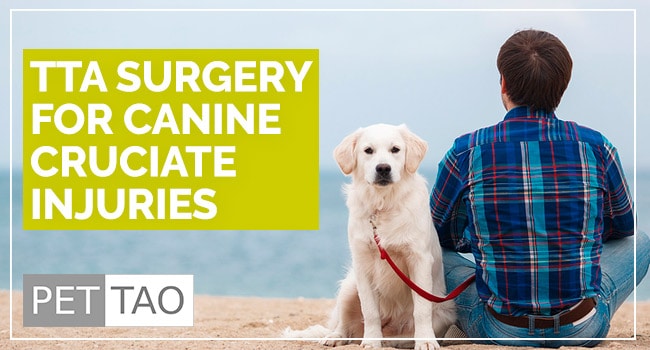TTA (Tibial Tuberosity Advancement) is another commonly performed surgery for a torn ACL in dogs generally performed by board-certified surgeons.
It is not necessary to explain the exact surgical procedure since the goals of a TTA are very similar to the goals of a TPLO.
Outlining the differences between the two procedures will be of more benefit.
Like the TPLO, the TTA is termed a “bone cutter” and requires an osteotomy or cutting of the bone to achieve the desired result.
Many of the same complications for the TPLO also apply to the TTA.
The recommendation of TPLO or TTA is made based on the surgeon’s preference.
So what are the main differences between the TPLO and TTA?
The TPLO requires more soft tissue elevation.
Dogs who undergo TTA regain use of the limb faster than dogs who undergo TPLO because of the greater soft tissue elevation.
Frequently, dogs who undergo TTA begin to use the leg 5-7 days after surgery.
TTA is a simpler technique which many general practitioners perform.
TTA implants have a slender profile and are generally made of titanium whereas TPLO implants are frequently made of stainless steel and tend to be bulky.
Therefore, swelling on the inside of the knee tends to be more pronounced in TPLO-treated dogs then TTA-treated dogs.
Following TTA surgery, the tibial tuberosity is more pronounced and some owners find the appearance cosmetically unacceptable.
Why Would a Surgeon Recommend a TPLO or TTA When Other Less Invasive Techniques Exist?
Surgical Preference
When a technique is mastered, oftentimes it is just easier to go with what you know best.
Size of the Dog
As a rule of thumb, dogs weighing over 50 pounds need a “bone cutter” surgery or TightRope.
However, at times I disagree and prefer to make decisions on a case-by-case basis.
Many dogs weighing over 50 pounds do well with other techniques. It depends on the dog.
Age and Size of the Dog
Young, larger dogs, in my opinion, need a “bone cutter.”
Why? Because one of the goals of surgery is to prevent the progression of arthritis.
“Bone cutters” are quite effective in limiting the progression of arthritis compared to other procedures.
TPLO and TTA can be used in the most active (athletic) dogs of large size with good to excellent results.
The greatest number of complications with a lateral suture stabilization occur in younger, more athletic dogs.
I feel “bone cutter” is an overall better choice for young, athletic dogs.
Additionally, there are many anecdotal reports showing a faster recovery with the listed techniques, and postoperative weight-bearing is not unusual within the first 24 hours after surgery.
Finally, there is additional anecdotal evidence showing athletic dogs perform close to their pre-injury status (hunting, field trial, etc.) which has not been the case historically with other techniques (namely the lateral suture).
Interested in more ways to improve your pet’s health and wellness?
Learn More About Options for Dogs with Cruciate Injury
Powerful Tools to Help Your Dog’s Ligament Challenges
There are many quick and easy changes you can make at home to help your give your dog an edge on easing tendon and ligament challenges.
- Learn more about torn ligaments and cruciate disease.
- Provide joint support. PET | TAO’s Harmonize Joint is a blend of Eastern herbs and Western supplements working together to lubricate and restore your dog’s joints.
- Ease your dog’s discomfort naturally. PET | TAO’s Comfort is a blend of Eastern herbs and Western supplements to soothe your dog’s arthritic challenges to make him/her more comfortable.
- Try PET | TAO Freeze Dried Beef Liver Treats. According to TCVM, liver controls tendons and ligaments. As few as 5-6 treats per day can make a huge difference in your dog’s tendon and ligament health!
- Try a Blood-building TCVM Diet. PET | TAO Zing dog food builds Blood. According to TCVM, Blood deficiency leads to ligament tears.
- Learn more about TCVM Herbal Remedies. Chinese medicine offers many amazing natural solutions for ligament and cruciate challenges. Some good examples are:








